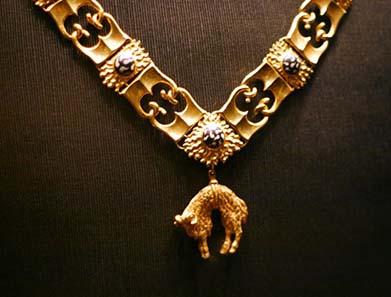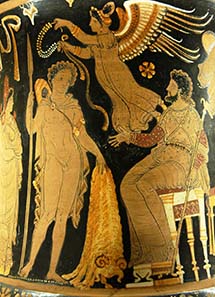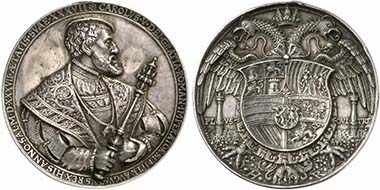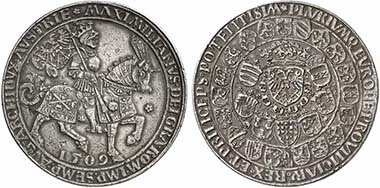Countless coins from the Holy Roman Empire show something many catalogs briefly address as “neck chain” of the Order of the Golden Fleece. That order was created by Philipp the Good of Burgundy on the occasion of his wedding with Princess Isabella of Portugal on January 10, 1430.
Order of the Golden Fleece. Fotograph: Peter Gerstbach / Wikipedia.
That was without doubt politically charged for Philipp the Good, Duke of Burgundy, who therewith declared his volte-face. The founding of the order coincided with the Hundred Years’ War between England and France in which Burgundy tipped the scales more than once. From 1415 onwards, Burgundy was on the side of the victorious Englishmen. In that year, they virtually occupied the entire Normandy and the French capital. In 1430, however, the worm seemed to have turned: led by a maiden, the French army had relieved the city of Orleans the previous year, and Charles VII was anointed King of France in Reims shortly thereafter. These events led Philipp the Good to reconsider his close alliance with the English king. On the other hand, in the present situation it wasn’t advisable to fall out with him entirely. Hence, Philipp was in trouble when Henry VI of England wanted to call him to the Order of the Garter on the occasion of his wedding in 1430. After all, the members of this order of chivalry were bound to eternal loyalty towards their Grand Master. A piece of good advice was in order and thus Philipp immediately founded his own order of knighthood whose members – of course – were forbidden to belong to any other order than the one of the Sacred Fleece.
Philip the Good, painting by Rogier van der Weyden around 1450. Source: Wikipedia.
On November 30, 1431, on the feast of St. Andrew, patron saint of the duke of Burgundy, Philipp invited to the first festive gathering of the order’s chapter to make the articles of the new order of chivalry public. When the order was founded, membership was restricted to 30 knights under a Grand Master – later, this number was increased significantly. They were supposed to be ‘noble people of name and coat of arms’. They had to be ‘truly devoted’ to the Duke of Burgundy, the Grand Master of the order – after all, membership was intended to bind important noble people to the Burgundian court. Main objective was and still is – for the order still exists – to promote and defend the Christian faith (although not only Christians belong to the order). That is why going to church and mass figure prominently in the order’s ritual.
Originally, the order was intended to be an inseparable bond between members of equal rank who were supposed to behave brotherly towards each other, without social distinction. The knights of the order were exempt from any contributions and were subject only to the jurisdiction of their own order. They were given the advantage as long as no crowned head was present.
Jason takes the Golden Fleece to Pelias. Louvre, calyx krater 340-330 B. C. Source: Wikipedia.
The Golden Fleece was chosen as symbol – that, however, wasn’t a good choice. The duke who was very fond of antiquity probably had a knightly community in mind that had embarked to face adventures – just like Jason and his comrades. The knights, however, having a knowledge of ancient mythology at least as profound, objected against that – a raid to seize the Golden Fleece, a sorcerer whose interference only made the taking possible – the pious 15th century considered that a bit too pagan for an order of knights which explicitly dedicated itself to the protection of the faith. Since the name was already in existence, it was re-interpreted. Now, a connection with the Old Testament and the story of Gideon was established. He had asked God for a sign to prove him being the chosen one to rescue Israel from its enemies. God dewed a ram’s skin while the surrounding ground remained dry. That story was a popular analogy to the Immaculate Conception of Mother of God. It likewise included a Golden Fleece, and so the pious legend was suited to explain the symbol of the order of Christian knight.
Charles V. Cast silver medal after H. Reinhart. Half-length portrait with the Order of the Golden Fleece. Rev. double eagle with coat of arms. From auction Künker 189 (2011), 1570.
Duke Philipp the Good had chosen the following motto when he ascended the throne in 1419: “Ante ferit quam flamme micet” (= It strikes before the flame flickers). As an illustration he introduced a flint and a fire-steel. These two elements are to be seen on the chain. The flints are enameled hemispheres with white flames darting against a black background, the fire rams have become chain links – one fire ram stands for a member of the order, two for a Grand Master. The underlying idea of the chain reads as follows: just like a chain is intact only when every single chain link is intact, so the order should gain cohesion by every single member.
Maximilian I. Schauguldiner 1509, minted in 1517 in Antwerp on the assumption of the imperial title. Cuirassed emperor riding r. Rev. Crowned coat of arms, sorrounded by other coats of arms, around the inner one chain of the Order of the Golden Fleece.
From auction Künker 188 (2011), 577.
With Maximilian I marrying the Burgundian heiress the grandmastership was transferred to the House of Habsburg. After the Spanish line of this dynasty had died out two ruling houses claimed inheritage: the Austrian House of Habsburg and the Spanish line of the House of Burbons. Up to the present day the descendants of these two dynasties execute the grandmastership over the orders that have been separated by now. The chair of the Austrian Order of the Golden Fleece holds Charles II of Habsburg-Lothringen, 16th Head of the House of Habsburg. The Spanish branch is presided by Juan Carlos I of Spain since 1938. He has turned the Order into a truly royal community. Members (current or former) are inter alia (in order of joining): Constantine, King of Greece, Charles Gustav, King of Sweden, Jean, Grand Duke of Luxembourg, Akihito, Emperor of Japan, Hussein, King of Jordan, Beatrix, Queen of the Netherlands, Margrethe, Queen of Denmark, Elizabeth, Queen of the Commonwealth realms, Albert II, King of the Belgians and Harald V of Norway.








